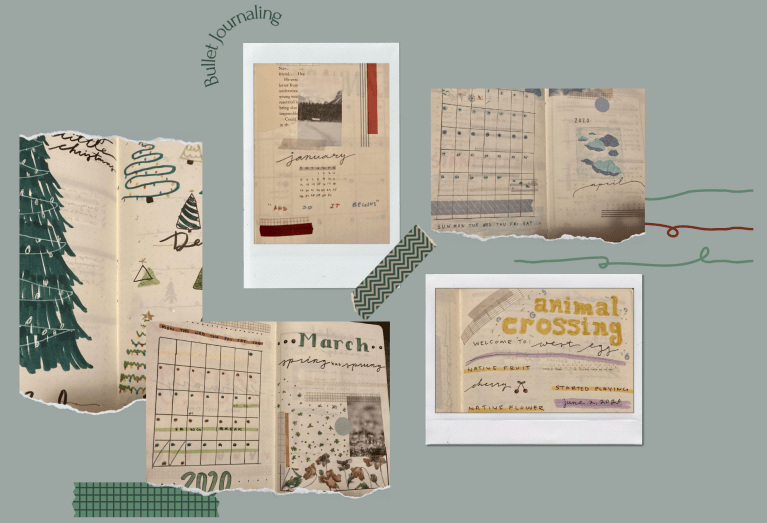In 2019, before everything went downhill, I decided to bullet journal for the new year.
Bullet journaling is an organizational method created by digital product designer Ryder Carroll. It is a planner and art journal that is completely customizable by its user, consisting of the typical planner aspects (calendars, to-do lists, spaces for quick-notes, etc.) with its own flairs typical among the internet community (habit and mood trackers) and additions by its creator (goals and affirmations, bucket lists, playlist spreads, video game trackers, etc.) With the popularity of bullet journaling on Instagram and YouTube, from creators such as @AmandaRachLee and @studyquill, Carroll’s original simple design for the process has transformed into something “aesthetically pleasing.” Journalers across both platforms present unique themes, using a range of artistic mediums, processes and supplies to achieve style alongside productivity.
With the freedom and inspiration from online, I picked up a 250-page dotted grid notebook and started my bullet journal journey for 2020.
The Good
The first thing I enjoyed about bullet journaling was the freedom to artistically express myself. I challenged myself to try out new art methods, from writing calligraphy to making collages to doodling Christmas trees. Whatever the method, it was up for me to decide. It could be simple or extravagant, artsy or organizational, experimental or habitual. I learned to find inspiration and grow within the larger bullet journaling community on platforms like Instagram and YouTube. Gaining knowledge and ideas from tutorials and “Plan with Me” videos helped improve my art skills.
I run a separate Instagram for my art, and keeping a bullet journal created a lot of content for it. Alongside publishing my creative writing, I also posted my monthly spreads, special spreads and updates regarding my process with the method. This allowed me to catalog how I felt about bullet journaling, what was going on at the time of a spread and what else was happening in my life.
Lastly, bullet journaling was a way of stress relief. While making a spread may seem complex and confusing to start, actually engaging in it was a way to calm me down. I was able to release my anxieties onto the page with strokes of a pen, stickers, washi tapes and color, while organizing the chaos of my life.
The Bad
However, bullet journaling had its cons. One: it was very difficult to maintain. I had a much easier time keeping up my journal during high school, especially when lockdown began. But in the summer, while I did create special spreads (like one for “Animal Crossing: New Horizons”), I did not have much to plan, leading me to neglect it. When back-to-school season rolled around, I found myself using it more to organize the jam-packed events of online university. But I ceased using it again once school picked up and I was more focused on writing papers than coloring a doodle of jack-o-lanterns. I did almost no bullet journaling in October, making a spread in a lazy fashion (a spread I am not proud of), and in November I made something simple with one week of the month left. I used my bullet journal all of December, having minimal events and meetings and using it mostly to do my daily journal challenge I do every December. Despite this December uptick, it has been difficult, at large, for me to remain inconsistent.
Another regret I have is that I dropped regular journaling. I used to journal every other day, using it a method of free therapy. I was able to calm my anxieties for the majority of my senior year of high school. However, once I started bullet journaling, and, again, due to the time constraints that come with it, I found myself focusing less on my emotions and feelings and more on aesthetically planning out my day. And I dropped journaling at the worst time possible: With all the chaos that happened last year, I forgot how to reflect and check-up on how I was doing.
As bullet journaling was a way to learn from others, it was also easy for me to compare myself and feel bad about my journal. I’m a decent artist, not the best by any means, but the way journals appeared on my screen were, to me, always better. Allowing myself to constantly compare my journal hindered a goal of personal validation and replaced it with the need for external validation. A personal goal I have for the new year is to gain confidence in my work and use outside resources not as a way to put down myself, but rather for support.
Lastly, social media has its downsides, especially with the bullet journal community. Content creators unintentionally promote a consumerist mindset, taking pictures of all their expensive stationery. Not only does it produce an unrealistic image of what is needed for bullet journaling, but it paints a narrative that excludes those who cannot afford those supplies and makes “stationery addictions” relatable. I definitely was impacted by this mindset and want to stray away from that path for this year, saving my money for more important things.
Ultimately, I love the artistic side of bullet journaling and will continue adding art, doodles, collages, etc. to the traditional journal and planner I plan keeping for 2021. However, I will not have a 2021 bullet journal because of how much time it took to think of themes, create them and fill them out with effort and make them useful. Maintaining a bullet journal was not as efficient for me, a busy student who wanted to dedicate their time to other activities. However, this may not be a forever good-bye; I might return to bullet journaling if my method for planning for 2021 does not work out. But, if you have the drive and want to make time for bullet journaling, I say go for it. I did, but my motivation ceased as I trudged through 2020.
Contact Kyla Figueroa at kylafig5 ‘at’ stanford.edu.
